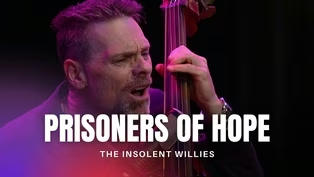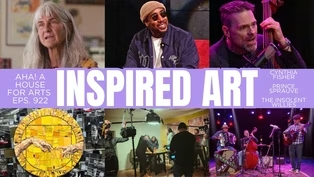
How Cynthia Fisher Mastered Mosaic Art
Clip: Season 9 Episode 22 | 7m 22sVideo has Closed Captions
Discover Cynthia Fisher's journey from children's book illustrator to master mosaic artist.
Join us on AHA! A House for Arts as Cynthia Fisher of Big Bang Mosaics shares her incredible journey from children's book illustration to becoming a renowned mosaic artist. Based in Charlemont, MA, Cynthia’s work is inspired by science and nature, spanning public art projects, community work in Guatemala, and personal artistic explorations.
Problems playing video? | Closed Captioning Feedback
Problems playing video? | Closed Captioning Feedback
AHA! A House for Arts is a local public television program presented by WMHT
Support provided by the New York State Council on the Arts (NYSCA), M&T Bank, the Leo Cox Beach Philanthropic Foundation, and is also provided by contributors to the WMHT Venture...

How Cynthia Fisher Mastered Mosaic Art
Clip: Season 9 Episode 22 | 7m 22sVideo has Closed Captions
Join us on AHA! A House for Arts as Cynthia Fisher of Big Bang Mosaics shares her incredible journey from children's book illustration to becoming a renowned mosaic artist. Based in Charlemont, MA, Cynthia’s work is inspired by science and nature, spanning public art projects, community work in Guatemala, and personal artistic explorations.
Problems playing video? | Closed Captioning Feedback
How to Watch AHA! A House for Arts
AHA! A House for Arts is available to stream on pbs.org and the free PBS App, available on iPhone, Apple TV, Android TV, Android smartphones, Amazon Fire TV, Amazon Fire Tablet, Roku, Samsung Smart TV, and Vizio.
Providing Support for PBS.org
Learn Moreabout PBS online sponsorship- As a mosaic artist, I do quite a wide variety of kinds of work and styles of work.
I use a wide variety of materials and I do a lot of different kinds of projects, so I do work for the public sector, hospitals, or cities, and I also do a lot of work for people in their homes.
For instance, backsplash in a kitchen or shower stall, and then I also work on mosaics in community projects and I go to Guatemala every year, and that's a huge part of what I do as a mosaic artist.
(lively music) Also, I create my own work and, for me, that's really important because I get to come up with a concept and explore what I want to explore and take more chances with the medium.
(lively music) I was a children's book illustrator, and I had done that for about 10 years when I took my first mosaic class, and it changed my life.
The field of illustration is such that you develop a style and then you have to stick to that style, so it's kind of like the antithesis of being an artist, where an artist should always be willing to try new things, I think, and explore and grow.
As an illustrator, you wanna come up with a style that says, "This is me.
When you see this, you recognize it as mine."
And so, it's kinda like a stop sign with doing creative stuff.
So when I started doing mosaics, it was like opening the world of true art, true fine art.
I just was really drawn to it.
I think part of it is just the tactile nature of working with your materials in your hand.
There are a lot of things that you can't do with mosaics, like there's no mixing of colors.
Sometimes that's really frustrating, but other times it's really an opportunity for you to do things that you wouldn't have done if it was easy to just have any color in the rainbow.
You still have to be creative, and I love that challenge.
(lively music) The history of mosaics is such a rich history going back to the Roman era.
However, mosaics really have been created all over the world.
The world of Islam, they make incredible mosaics that are out of clay, and it's quite different from the Roman style.
Then there's also the mosaics of Gaudi in Barcelona, so anyone who's been to Barcelona is gonna have seen the mosaics there, and in Barcelona the mosaics are much more design-oriented and they're not representational, and they're exquisite.
They're every bit as beautiful as the Roman style.
The Romans, however, brought the idea of making art that way, really to an elevated art form.
They had a whole language of how they laid the tile, and everything was representational.
The materials they used were marble and stone, and they were able to create incredible artworks with a really limited palette.
There's so many different directions that you can go within the medium of mosaics, and it's a pretty specific part of the art world but, even within it, you can do all kinds of stuff.
So I am going to be demonstrating how to do the attachment phase of working in the indirect method.
In mosaics, there are different ways of putting a mosaic together, and the main distinctions are something that one calls the direct method or the indirect method.
You have to do a mosaic in the direct method when you have something sculptural, 'cause you have to cut your pieces of tile and attach them until you cover up whatever your three-dimensional object is.
I work in the indirect method which is one where you start out on a temporary substrate that is sticky mesh.
Once you finish laying that mosaic and you decide, "Okay, now I love it, it's perfect," then you have to attach it to a panel.
It's a whole process of putting sticky paper on the top, and then you put a board under and a board over and flip it over.
What you're seeing here is the mosaic upside down and backwards, and it is going to end up permanently attached to this panel.
So the way we do that, I've already mixed up my thin-set, thin-set mortar.
(lively music) You put a thin coat of thin-set down.
Now is when we do the flip.
This is the backside of the mosaic, so we need to simply drop this onto the backside push it down well.
(lively music) I've done this process with pieces that are three feet by five feet, with help.
(lively music) I'm gonna take this sticky paper off right now, slowly,.
And there she glows.
And then you still have to grout it.
The beauty of the indirect method is that when you're working on whatever it is you're doing, you don't have to have a clear mind's eye version of what it's gonna look like because it's super easy to change as you go along.
(lively music) A lot of my personal work is based on math and scientific principles.
I'm a big reader and I am fascinated by our species, human beings, and what makes us human.
(lively music) For the past couple of years or so I've been working on a series called "Peregrinations on Being Human."
So, I have a mosaic that represents the brain, thinking of the right side of the brain versus the left side of the brain.
I have a diptych on the financial inequality that we have and how the rich are getting richer and the poor are not getting richer.
(lively music) I feel like it's a series that I'll just keep on working on when I have the time, I always fit that in between my commission work whenever I can.
(lively music) I've been going to Guatemala since 2013.
The first time I went was just because I wanted to try doing a community project in another country.
I've known other artists, mosaic artists, who've done it, and the idea really appealed to me.
So now I've been going to the same town since 2017.
For the past five years, I've been bringing groups of Americans, and it's a really rich experience, culturally.
There are now, I think, over 35 mosaics in town, and one of the really cool things is that now people are approaching me and saying, "Hey, what do I need to do to get a mosaic?"
It's still worth it to be doing mosaics with people and turning them onto the medium, I just know it will always be part of my life.
Mosaics clearly are my world.
(lively music)
How a High School Program Sparked a Filmmaking Revolution
Video has Closed Captions
Clip: S9 Ep22 | 9m 54s | Prince Sprauve's journey from Schenectady High to acclaimed filmmaker. (9m 54s)
The Insolent Willies Perform "Black Cats And A Blowtorch"
Video has Closed Captions
Clip: S9 Ep22 | 3m 5s | Join The Insolent Willies in a riveting performance of"Black Cats And A Blowtorch". (3m 5s)
The Insolent Willies Perform "Prisoner Of Hope"
Video has Closed Captions
Clip: S9 Ep22 | 2m 45s | Join The Insolent Willies in a riveting performance of "Prisoner Of Hope". (2m 45s)
Inspired Art: Cynthia Fisher, Prince Sprauve, and The Insolent Willies - Preview
Video has Closed Captions
Clip: S9 Ep22 | 30s | Explore art, film, and music with Cynthia Fisher, Prince Sprauve, and The Insolent Willies on AHA! (30s)
Providing Support for PBS.org
Learn Moreabout PBS online sponsorshipSupport for PBS provided by:
AHA! A House for Arts is a local public television program presented by WMHT
Support provided by the New York State Council on the Arts (NYSCA), M&T Bank, the Leo Cox Beach Philanthropic Foundation, and is also provided by contributors to the WMHT Venture...



















